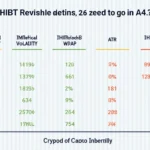Bitcoin Halving Historical Analysis: Understanding Its Impact on Market Dynamics
In the ever-evolving world of digital currencies, one of the most anticipated events is the Bitcoin halving. With tremendous implications for miners, investors, and the market, understanding this phenomenon is paramount. Historically, Bitcoin halvings have drastically influenced the price and the overall dynamics of the cryptocurrency market. But what exactly is Bitcoin halving, and how does it shape the economic landscape of digital assets?
To put things into perspective, since the inception of Bitcoin, there have been three major halving events (2012, 2016, and 2020), with the next one expected around 2024. Each of these events has led to significant market changes, increasing Bitcoin’s value and also impacting alternatives in the crypto market. Let’s explore these elements in greater detail.
Understanding Bitcoin Halving
Bitcoin halving refers to the process where the reward for mining new blocks is cut in half. This event occurs approximately every four years, or after 210,000 blocks have been mined. The halving is an integral part of Bitcoin’s monetary policy, intended to control inflation and ensure that the total supply of Bitcoin does not exceed 21 million. Understanding its mechanisms provides insights into its potential market impacts.

- First Halving (2012): The initial reward of 50 BTC per block was reduced to 25 BTC.
- Second Halving (2016): This saw the reward drop from 25 BTC to 12.5 BTC.
- Third Halving (2020): The most recent halving reduced the block reward to 6.25 BTC.
This structured reduction in reward creates a scarcity effect akin to precious metals. As new Bitcoins become harder to acquire, the demand can surge, thus influencing the price positively.
The Market Reactions to Past Halvings
The historical data surrounding Bitcoin halvings is rich with examples of how the market has reacted. In each instance, we’ve seen substantial bull runs in the months following a halving event. For example:
- Post-2012 Halving: The price of Bitcoin surged from about $11 to over $1,000 within a year.
- Post-2016 Halving: Prices increased from $650, peaking at nearly $20,000 by the end of 2017.
- Post-2020 Halving: Bitcoin rallied from around $8,500 and peaked at approximately $64,000 in April 2021.
This pattern indicates that new supply shocks created by halvings can lead to increased demand and consequently higher prices, a crucial point for investors.
The Role of Miner Sentiment and Market Speculation
One of the essential elements of Bitcoin’s pricing mechanism post-halving is miner sentiment. Miners are incentivized to hold their Bitcoin instead of selling immediately post-halving, creating additional liquidity in the market. This aspect is compounded by speculative trading, where market participants buy on the expectation of future price increases.
For instance, after the 2020 halving, many miners opted to hold their BTC, leading to reduced selling pressure. Consequently, this behavior played a critical role in fueling the rapid price increase seen shortly afterward.
The Implications for Altcoins and the Broader Crypto Market
The effects of Bitcoin halving extend beyond Bitcoin itself. Traditionally, altcoins experience price surges in correlation with Bitcoin’s price movements. In the months following previous halvings, many altcoins, such as Ethereum and Litecoin, have experienced significant growth.
- 2024 Halving Predictions: With analysts predicting the next Bitcoin halving could occur around May 2024, many are already observing increases in altcoin prices.
- Market Sentiment: Interest from private and institutional investors in the crypto space has been on the rise, especially in Vietnam, which has seen a 300% increase in crypto traders in 2023.
Halfway to 2025: What’s Next?
With the anticipation of the next halving, discussions surrounding 2025’s most promising altcoins intensify. As Bitcoin continues to solidify its position, investors are focusing on scalability, usability, and innovative technologies within the altcoin sector.
To seize potential opportunities, investors should enhance their knowledge about the Vietnam crypto market, where a growing number of users are entering the space. The rise in trading volume and merchant adoption indicates a bright future for both Bitcoin and other cryptocurrencies.
Conclusion: Preparing for the Next Bitcoin Halving
In conclusion, the Bitcoin halving is not just an event; it is a catalyst that has driven substantial changes in the cryptocurrency market throughout its history. Understanding the implications of each halving can provide valuable insights for investors and traders alike. As we approach the next halving set for 2024, being aware of the trends and potential market shifts will be essential for navigating the crypto landscape effectively.
For those interested in diving deeper into Bitcoin halving strategies, consider utilizing resources like hibt.com for expert insights.
As we forecast the future, remember that the next halving represents not just a transition for Bitcoin but also offers a unique opportunity for the broader market, including emerging dynamics within the Vietnamese crypto scene. Stay informed and prepare for a potentially explosive growth phase in 2025.
Author: John Doe, a blockchain enthusiast with extensive experience analyzing market trends. He has published over 30 papers in the field and played a crucial role in auditing well-known projects.







